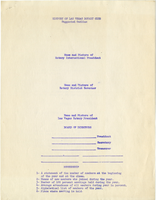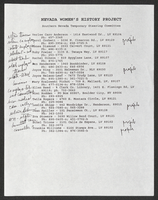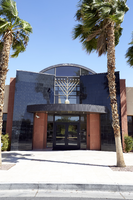Search the Special Collections and Archives Portal
Search Results

History of Las Vegas Rotary Club Outline
Date
Archival Collection
Description
Text
Las Vegas history
Level of Description
Archival Collection
Collection Name: North Las Vegas Library District Collection on Nevada
Box/Folder: N/A
Archival Component
Valorie J. Vega oral history interview
Identifier
Abstract
Oral history interview with Valorie J. Vega conducted by Laurents Bañuelos-Benitez on November 19, 2018 for the Latinx Voices of Southern Nevada Oral History Project. In this interview, Vega discusses her upbringing in Van Nuys, California. She describes her father’s employment with the Los Angeles County Fire Department, her attendance at California State University, Northridge, and majoring in Spanish with a minor in Chicano studies. Vega recalls entering a master’s program for Spanish interpretation, moving to Las Vegas, Nevada in 1978, and becoming a supervisor for court interpreters. Later, Vega talks about enrolling in law school at the University of Southern California (USC), working as a Clark County deputy attorney, and later becoming a judge. Lastly, Vega discusses her experience being a female Hispanic judge, and her involvement with the Huellas Program at the University of Nevada, Las Vegas (UNLV).
Archival Collection
Mary Hawkins oral history interview
Identifier
Abstract
Oral history interview with Mary Hawkins conducted by Bill Murphy on June 22, 1972 for the Ralph Roske Oral History Project on Early Las Vegas. In her interview Hawkins discusses her reasons for moving to Las Vegas, Nevada and the developmental changes she has seen occur in Las Vegas.
Archival Collection

Nevada Women's History Project organizational records
Date
Archival Collection
Description
Folder from the Nevada Women's History Project Records (MS-00406).
Text
Wilma Freemyer oral history interview
Identifier
Abstract
Oral history interview with Wilma Freemyer conducted by Suzanne Haag on February 22, 1979 for the Ralph Roske Oral History Project on Early Las Vegas. Freemyer discusses early Las Vegas, Nevada’s history during the 1930's and the
Archival Collection
J. K. Russ oral history interview
Identifier
Abstract
Oral history interview with J. K. Russ conducted by Claytee D. White on December 22, 2017 for the Remembering 1 October Oral History Project. In this interview, Russ discusses her early life in New Zealand and growing up on a tobacco farm. She remembers arriving to the United States and establishing a career as an artist. Russ talks about the 1 October shooting, creating an art exhibit using cards and letters received from people all over the world, and Las Vegas’ response to the tragedy. Lastly, Russ describes the art community in Las Vegas and the Arts District.
Archival Collection

Photograph of Chabad of Las Vegas, Las Vegas (Nev.), September 22, 2016
Date
Archival Collection
Description
The Chabad of Las Vegas at 1261 Arville Street.
Image
Las Vegas Strip, Las Vegas, Nevada, 1976 December 22
Level of Description
Archival Collection
Collection Name: North Las Vegas Library Photograph Collection on North Las Vegas, Nevada
Box/Folder: Folder 27
Archival Component

Photograph of Chabad of Las Vegas, Las Vegas (Nev.), September 22, 2016
Date
Archival Collection
Description
The Chabad of Las Vegas at 1261 Arville Street.
Image
